One Country, Several Droughts: Characterisation, Evolution, and Trends in Meteorological Droughts in Spain Within the Context of Climate Change
Abstract
1. Introduction
2. Materials and Methods
2.1. Monthly Meteorological Series, Quality Control (QC) and Homogenisation Process
2.2. Calculation of the SPEI
2.3. Regionalisation and Time Trends
3. Results
3.1. Types of Drought
3.1.1. SPEI-6 or Short-Term Droughts
3.1.2. SPEI-24 or Long-Term Droughts
3.2. Spatial and Time Variations in the Different Types of Drought (1950–2024)
3.2.1. SPEI-6 (Short-Term Droughts)
3.2.2. SPEI-24 (Long-Term Droughts)
4. Discussion
5. Conclusions
Supplementary Materials
Author Contributions
Funding
Data Availability Statement
Conflicts of Interest
Abbreviations
| SPEI | Standardized Precipitation Evapotranspiration Index |
| ECA | European Climate Assessment |
| ET | Evapotranspiration |
| LDPET | Potential Evapotranspiration |
References
- UNCCD. Global Drought Snapshot; United Nations: New York, NY, USA, 2023; Available online: https://www.unccd.int/sites/default/files/2023-12/Global%20drought%20snapshot%202023.pdf (accessed on 8 September 2025).
- Freedman, H.; AghaKouchak, A.; Rigden, A.J. Disparities in the impact of drought on agriculture across countries. Sci. Rep. 2025, 15, 13465. [Google Scholar] [CrossRef]
- Li, Q.; Ye, A.; Wada, Y.; Zhang, Y.; Zhou, J. Climate change leads to an expansion of global drought-sensitive area. J. Hydrol. 2024, 632, 130874. [Google Scholar] [CrossRef]
- Gebrechorkos, S.H.; Sheffield, J.; Vicente-Serrano, S.M. Warming accelerates global drought severity. Nature 2025, 642, 628–635. [Google Scholar] [CrossRef] [PubMed]
- Vicente-Serrano, S.M.; Peña-Angulo, D.; Beguería, S.; Domínguez-Castro, F.; Tomás-Burguera, M.; Noguera, I.; Gimeno-Sotelo, L.; El Kenawy, A. Global drought trends future projections. Phil. Trans. R. Soc. Math. Phys. Eng. Sci. 2022, 380, 20210285. [Google Scholar] [CrossRef] [PubMed]
- Chiang, F.; Mazdiyasni, O.; AghaKouchak, A. Evidence of anthropogenic impacts on global drought frequency, duration, and intensity. Nat. Commun. 2021, 12, 2754. [Google Scholar] [CrossRef]
- Alkhalidi, A.; Assaf, M.N.; Alkaylani, H.; Halaweh, G.; Salcedo, F.P. Integrated innovative technique to assess priorities risks associated with drought: Impacts measures/strategies actions global study. Int. J. Disaster Risk Reduct. 2023, 94, 103800. [Google Scholar] [CrossRef]
- Wens, M.; Johnson, J.M.; Zagaria, C.; Veldkamp, T.I.E. Integrating human behavior dynamics into drought risk assessment: A sociohydrologic, agent-based approach. Water 2019, 6, e1345. [Google Scholar] [CrossRef]
- Kchouk, S.; Melsen, L.A.; Walker, D.W.; van Oel, P.R. A geography of drought indices: Mismatch between indicators of drought and its impacts on water and food securities. Nat. Hazards Earth Syst. Sci. 2022, 22, 323–344. [Google Scholar] [CrossRef]
- Cresswell, C.; Ummenhofer, C.C.; Thatcher, D.L.; Wanamaker, A.D.; Denniston, R.F.; Asmerom, Y.; Polyak, V.J. Twenthieth Century Azores High expansion unprecedented in the last 1200 years. Nat. Geosci. 2022, 15, 548–553. [Google Scholar] [CrossRef]
- Garrido-Perez, J.M.; Vicente-Serrano, S.M.; Barriopedro, D.; García-Herrera, R.; Trigo, R.; Beguería, S. Examining the outstanding Euro-Mediterranean drought of 2021–2022 and its historical context. J. Hydrol. 2024, 630, 130653. [Google Scholar] [CrossRef]
- Outten, S.; Davy, R. Changes in the North Atlantic Oscillation over the 20th century. Weather. Clim. Dyn. 2024, 5, 753–762. [Google Scholar] [CrossRef]
- Singh, J.; Ashfaq, M.; Skinner, C.B. Enhanced risk of concurrent regional droughts with increased ENSO variability and warming. Nat. Clim. Chang. 2022, 12, e1345. [Google Scholar] [CrossRef]
- Sabzevari, Y.; Eslamian, S.; Pamula, A.S.P.; Bazrkar, M.H. Drought Trend Analysis Using Standardized Precipitation Evapotranspiration Index in Cold-Climate Regions. Atmosphere 2025, 16, 482. [Google Scholar] [CrossRef]
- Tomas-Burguera, M.; Vicente-Serrano, S.M.; Peña-Angulo, D.; Domínguez-Castro, F.; Noguera, I.; El Kenawy, A. Global characterization of the varying responses of the Standardized Precipitation Evapotranspiration Index to atmospheric evaporative demand. J. Geophys. Res. Atmos. 2020, 125, e2020JD033017. [Google Scholar] [CrossRef]
- Beguería, S.; Vicente-Serrano, S.M.; Reig, F.; Latorre, B. Standardized Precipitation Evapotranspiration Index (SPEI) revisited: Parameter fitting, evapotranspiration models, tools, datasets and drought monitoring. Int. J. Climatol. 2014, 34, 3001–3023. [Google Scholar] [CrossRef]
- Holgate, C.M.; Falster, G.M.; Gillett, Z.E.; Goswami, P.; Grant, M.O.; Hobeichi, S.; Hoffmann, D.; Jiang, X.; Jin, C.; Lu, X.; et al. Physical mechanisms of meteorological drought development, intensification and termination: An Australian review. Commun. Earth Environ. 2025, 6, 220. [Google Scholar] [CrossRef]
- Di Paola, A.; Di Giuseppe, E.; Magno, R.; Quaresima, S.; Rocchi, L.; Rapisardi, E.; Pavan, V.; Tornatore, F.; Leoni, P.; Pasqui, M. Building a framework for a synoptic overview of drought. Sci. Total Environ. 2025, 958, 177949. [Google Scholar] [CrossRef]
- Kirk, J.; Sheridan, S.; Schmidlin, T. Synoptic climatology of the early 21st century drought in the Colorado River Basin and relationships to reservoir water levels. Int. J. Climatol. 2016, 37, 2424–2437. [Google Scholar] [CrossRef]
- Parry, S.; Hannaford, J.; Lloyd-Hughes, B.; Christel Prudhomme, C. Multi-year droughts in Europe: Analysis of development and causes. Hydrol. Res. 2012, 43, 689–706. [Google Scholar] [CrossRef]
- OECD. Global Drought Outlook: Trends, Impacts and Policies to Adapt to a Drier World; OECD Publishing: Paris, France, 2025. [Google Scholar] [CrossRef]
- Motta, C.; Naumann, G.; Gomez, D.; Formetta, G.; Feyen, L. Assessing the eco-nomic impact of droughts in Europe in a changing climate: A multi-sectoral analysis at regional scale. J. Hydrol. Reg. Stud. 2025, 59, 102296. [Google Scholar] [CrossRef]
- Buras, A.; Rammig, A.; Zang, C.S. Quantifying impacts of the 2018 drought on European ecosystems in comparison to 2003. Biogeosciences 2020, 17, 1655–1672. [Google Scholar] [CrossRef]
- Edwards, B.; Gray, M.; Hunter, D. The social and economic impact of drought. CSRM Work. Pap. 2018, 5, 18. [Google Scholar] [CrossRef]
- Suleymanov, F. A review of the multifaceted relationship between drought dynamics and conflicts. Hydrol. Process. 2024, 38, e15262. [Google Scholar] [CrossRef]
- Páscoa, P.; Russo, A.; Gouveia, C.M.; Soares, P.M.; Cardoso, R.M.; Careto, J.A.; Ribeiro, A.F. A high-resolution view of the recent drought trends over the Iberian Peninsula. Weather Clim. Extrem. 2021, 32, 100320. [Google Scholar] [CrossRef]
- Villegas, P.; Carente, M.A.; Beltran, D. Economic impact of the drought in Spain: Measurement for the adoption of measures. Water Econ. Policy 2024, 10, 2450007. [Google Scholar] [CrossRef]
- Peña-Gallardo, M.; Vicente-Serrano, S.M.; Domínguez-Castro, F.; Beguería, S. The impact of drought on the productivity of two rainfed crops in Spain. Nat. Hazards Earth Syst. Sci. 2019, 19, 1215–1234. [Google Scholar] [CrossRef]
- Sánchez, E.; Hidalgo, S.; Bruna, J. La sequía en España: Análisis del fenómeno a través del estudio de las noticias de prensa recogidas por Hispagua durante el año 2005. In Scire: Representación y Organización del Conocimiento; Universidad de Zaragoza: Zaragoza, Spain, 2006; pp. 137–150. [Google Scholar] [CrossRef]
- Trullenque-Blanco, V.; Beguería, S.; Vicente-Serrano, S.M. Catalogue of drought events in peninsular Spanish along 1916–2020 period. Sci. Data 2024, 11, 703. [Google Scholar] [CrossRef]
- Torelló-Sentelles, H.; Franzke, C.L. Drought impact links to meteorological drought indicators and predictability in Spain. Hydrol. Earth Syst. Sci. 2022, 26, 1821–1844. [Google Scholar] [CrossRef]
- Lorenzo, M.N.; Alvarez, I.; Taboada, J.J. Drought evolution in the NW Iberian Peninsula over a 60 year period (1960–2020). J. Hydrol. 2022, 610, 127923. [Google Scholar] [CrossRef]
- Vicente-Serrano, S.M. La evolución de los estudios sobre sequías climáticas en España en las últimas décadas. Geographicalia 2021, 73, 7–34. [Google Scholar]
- Olcina Cantos, J. Tipología de sequías en España. Ería 2001, 56, 201–227. [Google Scholar]
- Miró, J.J.; Estrela, M.J.; Corell, D.; Gómez, I.; Luna, M.Y. Precipitation and drought trends (1952–2021) in a key hydrological recharge area of the eastern Iberian Peninsula. Atmos. Res. 2023, 286, 106695. [Google Scholar] [CrossRef]
- Moreno, M.; Bertolín, C.; Ortiz, P.; Ortiz, R. Satellite product to map drought and extreme precipitation trend in Andalusia, Spain: A novel method to assess heritage landscapes at risk. Int. J. Appl. Earth Obs. Geoinf. 2022, 110, 102810. [Google Scholar] [CrossRef]
- Ruiz Álvarez, V.; Portela, M.M.; Espinosa, L.Á.; García Marín, R.; Belmonte Serrato, F.; Ruiz Álvarez, M. Regionalization of droughts from the SPI in the Segura hydrographic basin and Commonwealth of Taibilla Channels (Southeast of Spain). Boletín Asoc. Geógrafos Españoles (BAGE) 2021, 88. [Google Scholar] [CrossRef]
- Ruiz-Sinoga, J.; García-Marín, R.; Martínez Murillo, J.; Gabarrón-Galeote, M. Precipitation dynamics in southern Spain: Trends and cycles. Int. J. Climatol. 2011, 31, 2281–2289. [Google Scholar] [CrossRef]
- Acero, F.J.; Gallego, M.C.; García, J.A. Multi-day rainfall trends over the Iberian Peninsula. Theor. Appl. Clim. 2012, 108, 411–423. [Google Scholar] [CrossRef]
- Serrano Notivoli, R. Reconstrucción climática instrumental de la precipitación diaria en España: Ensayo metodológico y aplicaciones. Ph.D. Thesis, Universidad de Zaragoza, Zaragoza, Spain, 2017. [Google Scholar]
- CEDEX. Impacto del Cambio Climático en las Precipitaciones Máximas en España, Madrid; Centro de Estudios Hidrográficos: Madrid, Spain, 2021; 404p. [Google Scholar]
- Senent-Aparicio, J.; López-Ballesteros, A.; Jimeno-Sáez, P.; Pérez-Sánchez, J. Recent precipitation trends in Peninsular Spain and implications for water infrastructure design. J. Hydrol. Reg. Stud. 2023, 45, 101308. [Google Scholar] [CrossRef]
- González-Hidalgo, J.C.; Brunetti, M.; De Luis, M. Precipitation trends in Spanish hydrological divisions, 1946–2005. Clim. Res. 2010, 43, 215–228. [Google Scholar] [CrossRef]
- Gonzalez-Hidalgo, J.C.; Beguería, S.; Peña-Angulo, D.; Trullenque-Blanco, V. MOPREDAS_century database and precipitation trends in mainland Spain, 1916–2020. Int. J. Climatol. 2023, 43, 3828–3840. [Google Scholar] [CrossRef]
- Gonzalez-Hidalgo, J.C.; Trullenque Blanco, V.; Beguería, S.; Peña-Angulo, D. Seasonal precipitation changes in the western Mediterranean Basin: The case of the Spanish mainland, 1916–2015. Int. J. Climatol. 2024, 44, 1800–1815. [Google Scholar] [CrossRef]
- Paredes, D.; Trigo, R.M.; Garcia-Herrera, R.; Trigo, I.F. Understanding precipitation changes in iberia in early spring: Weather typing and storm-tracking approaches. J. Hydrometeorol. 2006, 7, 101–113. [Google Scholar] [CrossRef]
- Miró, J.J.; Estrela, M.J.; Olcina-Cantos, J.; Martin-Vide, J. Future Projection of Precipitation Changes in the Júcar and Segura River Basins (Iberian Peninsula) by CMIP5 GCMs Local Downscaling. Atmosphere 2021, 12, 879. [Google Scholar] [CrossRef]
- González, A.; Santos, M.; Hernández, J.C.; Acosta, B.; Montalvo, J. Aumenta la frecuencia e intensidad de las sequías por el cambio climático en España. Fundación Matrix. Proyecto Climvac. 2020. Available online: https://fundacionmatrix.es/aumenta-la-frecuencia-e-intensidad-de-la-sequia-por-el-cambio-climatico-en-espana/ (accessed on 7 September 2025).
- Lana, X.; Casas-Castillo, M.C.; Rodríguez-Solà, R.; Serra, C.; Martínez, M.D.; Kirchner, R. Rainfall regime trends at annual and monthly scales in Catalonia (NE Spain) and indications of CO2 emissions effects. Theor. Appl. Clim. 2021, 146, 981–996. [Google Scholar] [CrossRef]
- Xian, T.; Xia, J.; Wei, W.; Zhang, Z.; Wang, R.; Wang, L.P.; Ma, Y.F. Is Hadley cell expanding? Atmosphere 2021, 12, 1699. [Google Scholar] [CrossRef]
- Olcina Cantos, J. Water Planning and Management in Spain in a Climate Change Context: Facts and Proposals. Cuad. Investig. Geográfica 2024, 50, 3–28. [Google Scholar] [CrossRef]
- Paneque, P. Estrategias de gestión de sequías en España: De la gestión de crisis a la gestión de riesgos. In Agua, Estado y Sociedad en América Latina y España; Contreras, J., Navarro, J.R., Rosas, S., Eds.; Consejo Superior de Investigaciones Científicas: Madrid, Spain; Escuela de Estudios Hispanoa-mericanos: Sevilla, Spain; Asociación Cultural la otra Andalucía: Andalucía, Spain, 2015; pp. 15–35. [Google Scholar]
- Wilhite, D. Drought: A Global Assessment; Routledge: New York, NY, USA, 2000; Volumes 1 and 2. [Google Scholar]
- Del Moral, L.; Hernández-Mora, N.; De Stefano, L.; Paneque, P.; Vargas, J.; Brufao, P.; Olcina, J.; Martínez-Fernández, J. Acerca del Real Decreto Ley 10/2017, de 9 de Junio, por el que se Adoptan Medidas Urgentes para Paliar los Efectos Producidos por la Sequía en Determinadas Cuencas Hidrográficas y se Modifica el texto Refundido de la Ley de Aguas, Aprobado por el Real Decreto Legislativo 1/2001, de 20 de Julio. Notas Para el Debate; Fundación Nueva Cultura del Agua: Zaragoza, Spain, 2017. [Google Scholar]
- Olcina, J.; Vera, J.F. Adaptación del sector turístico al cambio climático en España. La importancia de las acciones a escala local y en empresas turísticas. An. Geogr. 2016, 36, 321–352. [Google Scholar]
- Bates, B.C.; Kundzewicz, Z.W.; Palutikof, J.P. Climate change and water. In Technical Paper of the Intergovernmental Panel on Climate Change; IPCC Secretariat: Geneva, Switzerland, 2008. [Google Scholar]
- Klein Tank, A.M.; Wijngaard, J.B.; Können, G.P.; Böhm, R.; Demarée, G.; Gocheva, A.; Mileta, M.; Pashiardis, S.; Hejkrlik, L.; Kern-Hansen, C.; et al. Daily dataset of 20th-century surface air temperature and precipitation series for the European. Clim. Assess. Int. J. Climatol. 2002, 22, 1441–1453. [Google Scholar] [CrossRef]
- Alexander, L.; Herold, N. ClimPACT2: Indices and Software. 2016. Available online: https://epic.awi.de/id/eprint/49274/1/ClimPACTv2_manual.pdf (accessed on 10 September 2025).
- Guijarro, J.A. User’s Guide to Climatol. An R Contributed Package for Homogenization of Climatological Series; Report; State Meteorological Agency, Balearic Islands Office: Palma de Mallorca, Spain, 2011; Available online: https://www.climatol.eu/climatol4.2-0-en.pdf (accessed on 5 September 2025).
- Alexandersson, H.; Moberg, A. Homogenization of Swedish temperature data. Part I: Homogeneity test for linear trends. Int. J. Climatol. 1997, 17, 25–34. [Google Scholar] [CrossRef]
- Beguería, S.; Vicente-Serrano, S.M. SPEI: Calculation of the Standardized Precipitation-Evapotranspiration Index. 2023. Available online: https://github.com/sbegueria/SPEI (accessed on 5 September 2025).
- Vicente-Serrano, S.M.; Tomas-Burguera, M.; Beguería, S.; Reig, F.; Latorre, B.; Peña-Gallardo, M.; Luna, M.Y.; Morata, A.; González-Hidalgo, J.C. A high resolution dataset of drought indices for Spain. Data 2017, 2, 22. [Google Scholar] [CrossRef]
- Sepulcre-Canto, G.; Horion, S.M.A.F.; Singleton, A.; Carrao, H.; Vogt, J. Development of a Combined Drought Indicator to detect agricultural drought in Europe. Nat. Hazards Earth Syst. Sci. 2012, 12, 3519–3531. [Google Scholar] [CrossRef]
- Theil, H. A rank-invariant method of linear and polynomial regression analysis. Indag. Math. 1950, 12, 173. [Google Scholar]
- Sen, P.K. Estimates of the regression coefficient based on Kendall’s tau. J. Am. Stat. Assoc. 1968, 63, 1379–1389. [Google Scholar] [CrossRef]
- Mann, H.B. Non-parametric tests against trend. Econometrica 1945, 13. [Google Scholar] [CrossRef]
- Kendall, M.G. Rank Correlation Methods; Charles Griffin: London, UK, 1975. [Google Scholar]
- Hamed, K.H.; Rao, A.R. A modified Mann-Kendall trend test for autocorrelated data. J. Hydrol. 1998, 204, 182–196. [Google Scholar] [CrossRef]
- Urquijo-Reguera, J.; Gómez-Villarino, M.T.; Pereira, D.; De Stefano, L. An assessment framework to analyze drought management plans: The case of Spain. Agronomy 2022, 12, 970. [Google Scholar] [CrossRef]
- Meza, I.; Siebert, S.; Döll, P.; Kusche, J.; Herbert, C.; Eyshi Rezaei, E.; Nouri, H.; Gerdener, H.; Popat, E.; Frischen, J.; et al. Global-scale drought risk assessment for agricultural systems. Nat. Hazards Earth Syst. Sci. 2020, 20, 695–712. [Google Scholar] [CrossRef]
- Wu, J.; Geng, G.; Zhou, H.; Liu, J.; Wang, Q.; Yang, J. Global vulnerability to agricultural drought and its spatial characteristics. Sci. China Earth Sci. 2017, 60, 910–920. [Google Scholar] [CrossRef]
- Rossi, L.; Wens, M.; De Moel, H.; Cotti, D.; Sabino Siemons, A.; Toreti, A.; Maetens, W.; Masante, D.; Van Loon, A.; Hagenlocher, M.; et al. European Drought Risk Atlas; Publications Office of the European Union: Luxembourg, 2023. [Google Scholar] [CrossRef]
- Monjo, R.; Royé, D.; Martin-Vide, J. Meteorological drought lacunarity around the world and its classification. Earth Syst. Sci. Data 2020, 12, 741–752. [Google Scholar] [CrossRef]
- Gaitán, E.; Monjo, R.; Pórtoles, J.; Pino-Otín, M.R. Impact of climate change on drought in Aragon (NE Spain). Sci. Total Environ. 2020, 740, 140094. [Google Scholar] [CrossRef]
- Blauhut, V.; Stahl, K.; Stagge, J.H.; Tallaksen, L.M.; De Stefano, L.; Vogt, J. Estimating drought risk across Europe from reported drought impacts, drought indices, and vulnerability factors. Hydrol. Earth Syst. Sci. 2016, 20, 2779–2800. [Google Scholar] [CrossRef]
- Jiménez-Donaire, M.D.P.; Tarquis, A.; Giráldez, J.V. Evaluation of a combined drought indicator and its potential for agricultural drought prediction in southern Spain. Nat. Hazards Earth Syst. Sci. 2020, 20, 21–33. [Google Scholar] [CrossRef]
- Ortega-Gómez, T.; Pérez-Martín, M.A.; Estrela, T. Improvement of the drought indicators system in the Júcar River Basin, Spain. Sci. Total Environ. 2018, 610–611, 276–290. [Google Scholar] [CrossRef] [PubMed]
- Domínguez-Castro, F.; Vicente Serrano, S.M.; Tomás-Burguera, M.; Peña-Gallardo, M.; Beguería, S.; El Kenawy, A.M.; Luna, Y.; Morata, A. High spatial resolution climatology of drought events for Spain: 1961–2014. Int. J. Clim. 2019, 39, 5046–5062. [Google Scholar] [CrossRef]
- Vargas, J.; Paneque, P. Challenges for the integration of water resource and drought-risk management in Spain. Sustainability 2019, 11, 308. [Google Scholar] [CrossRef]
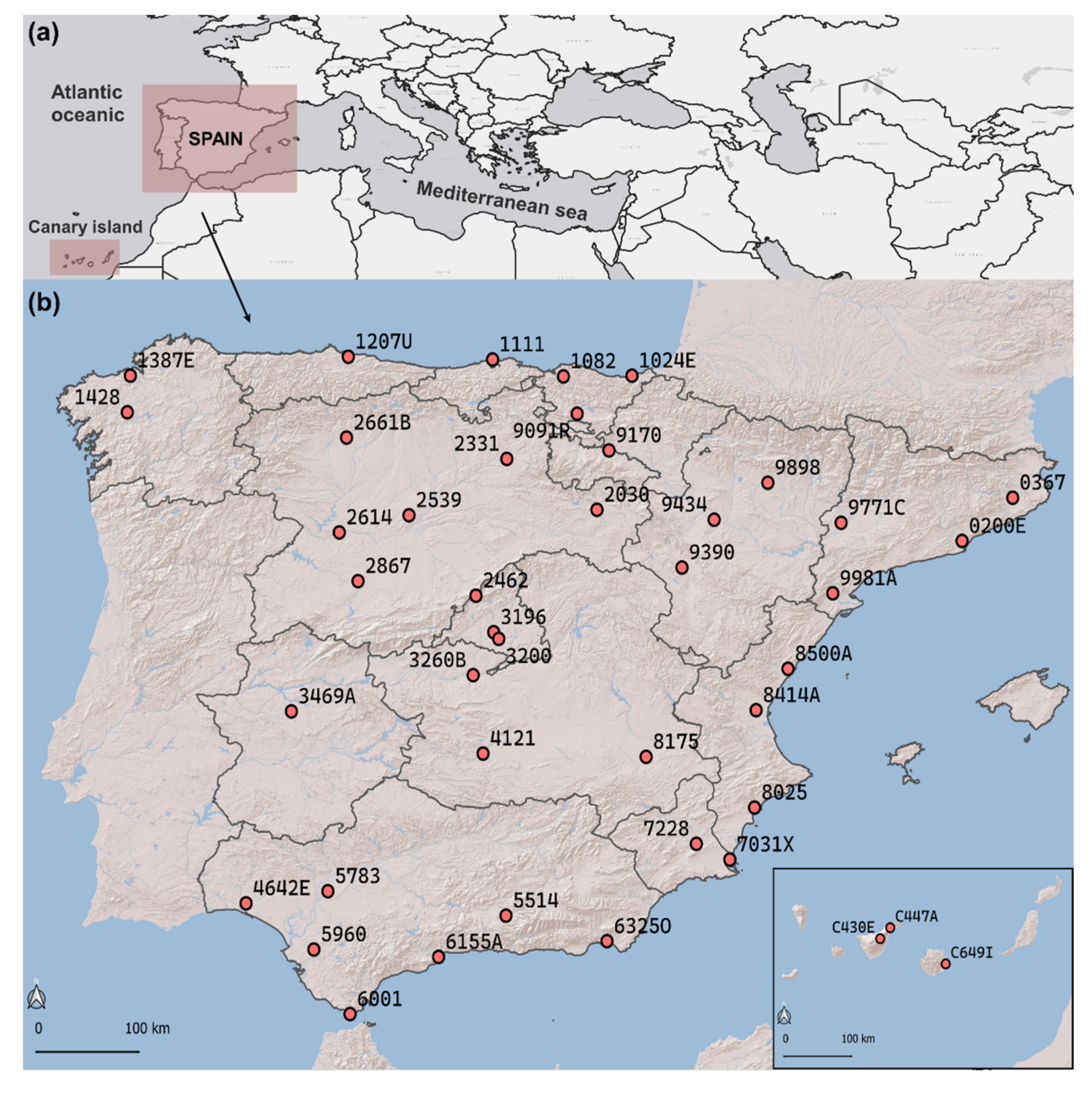
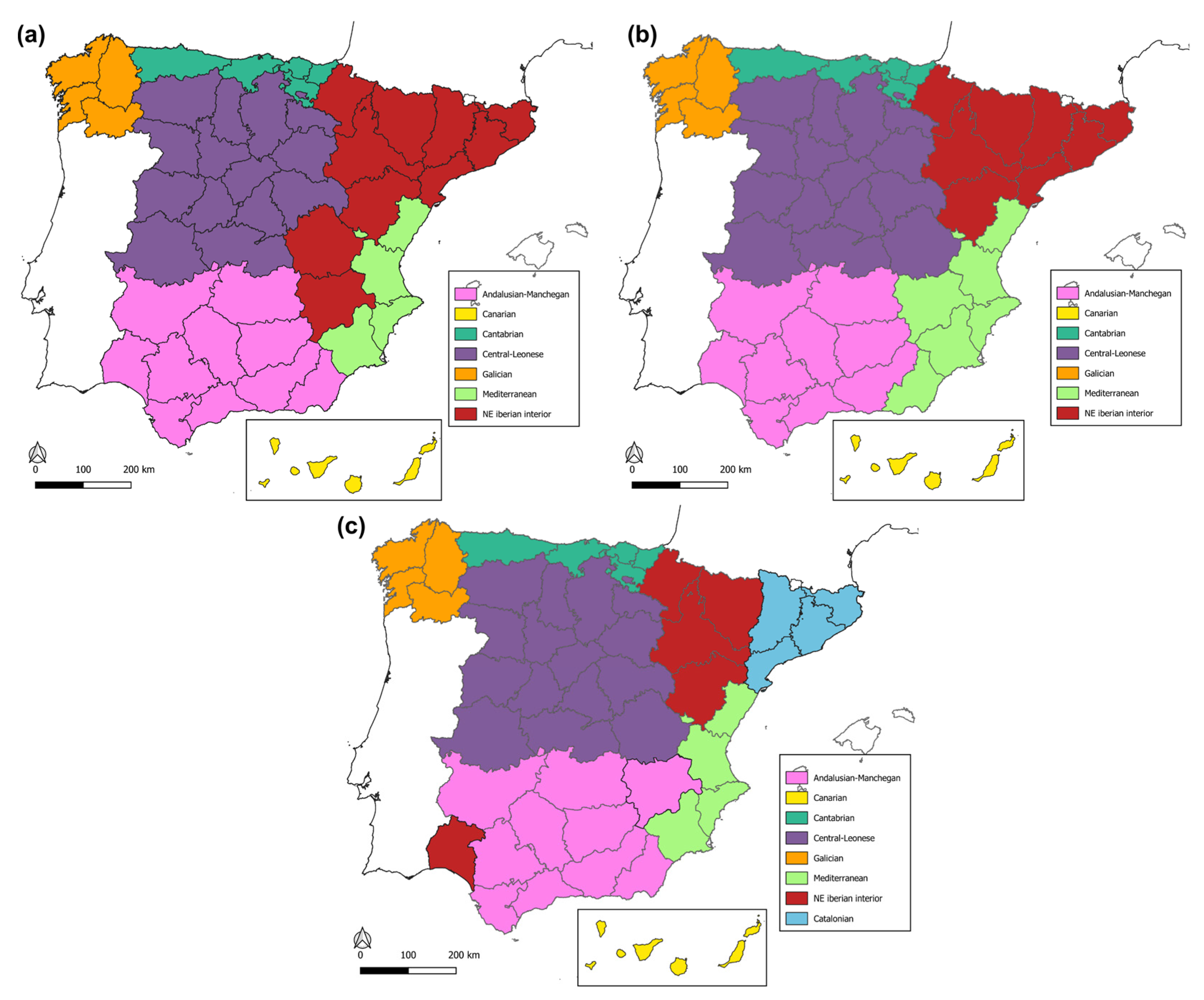

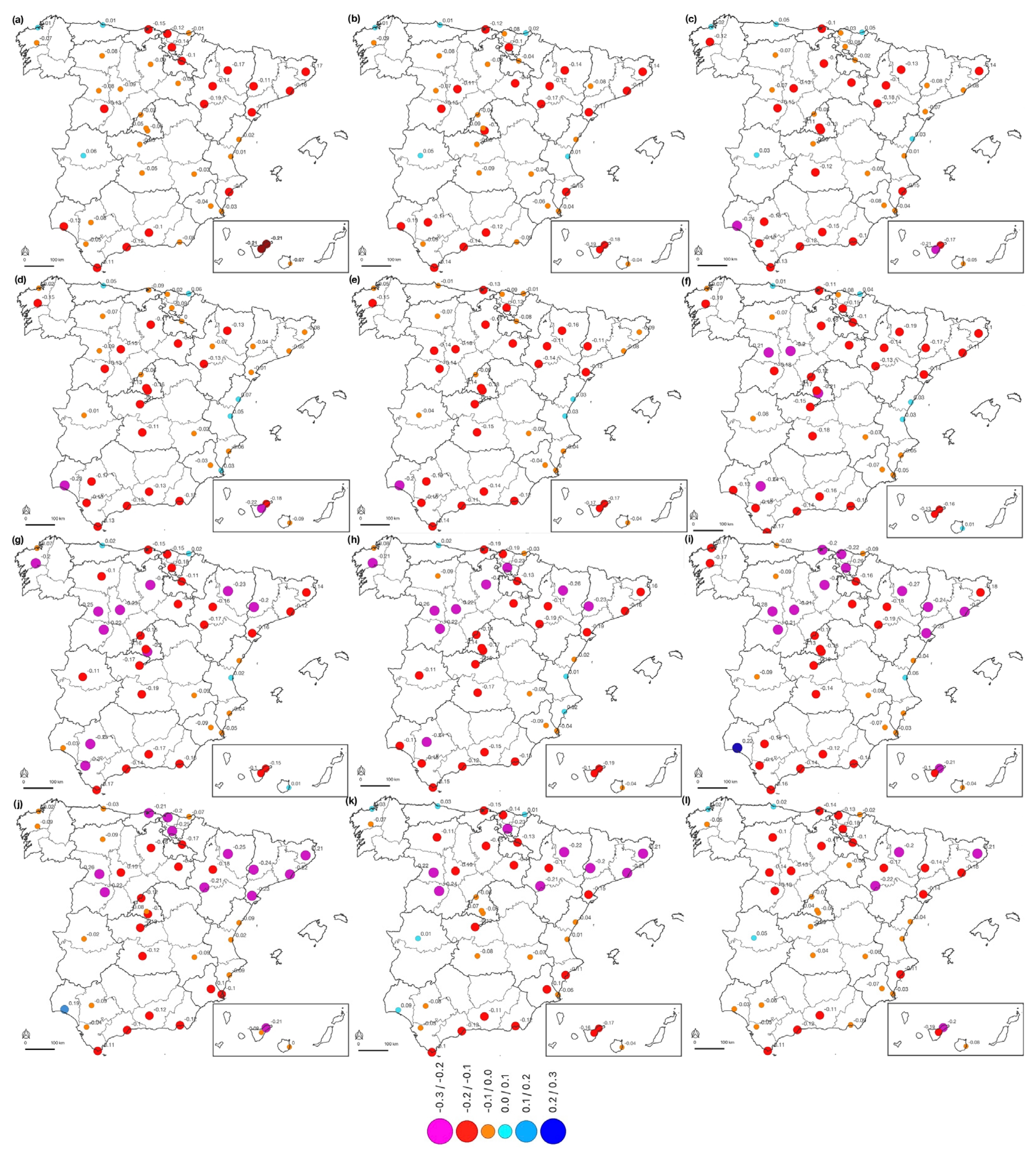
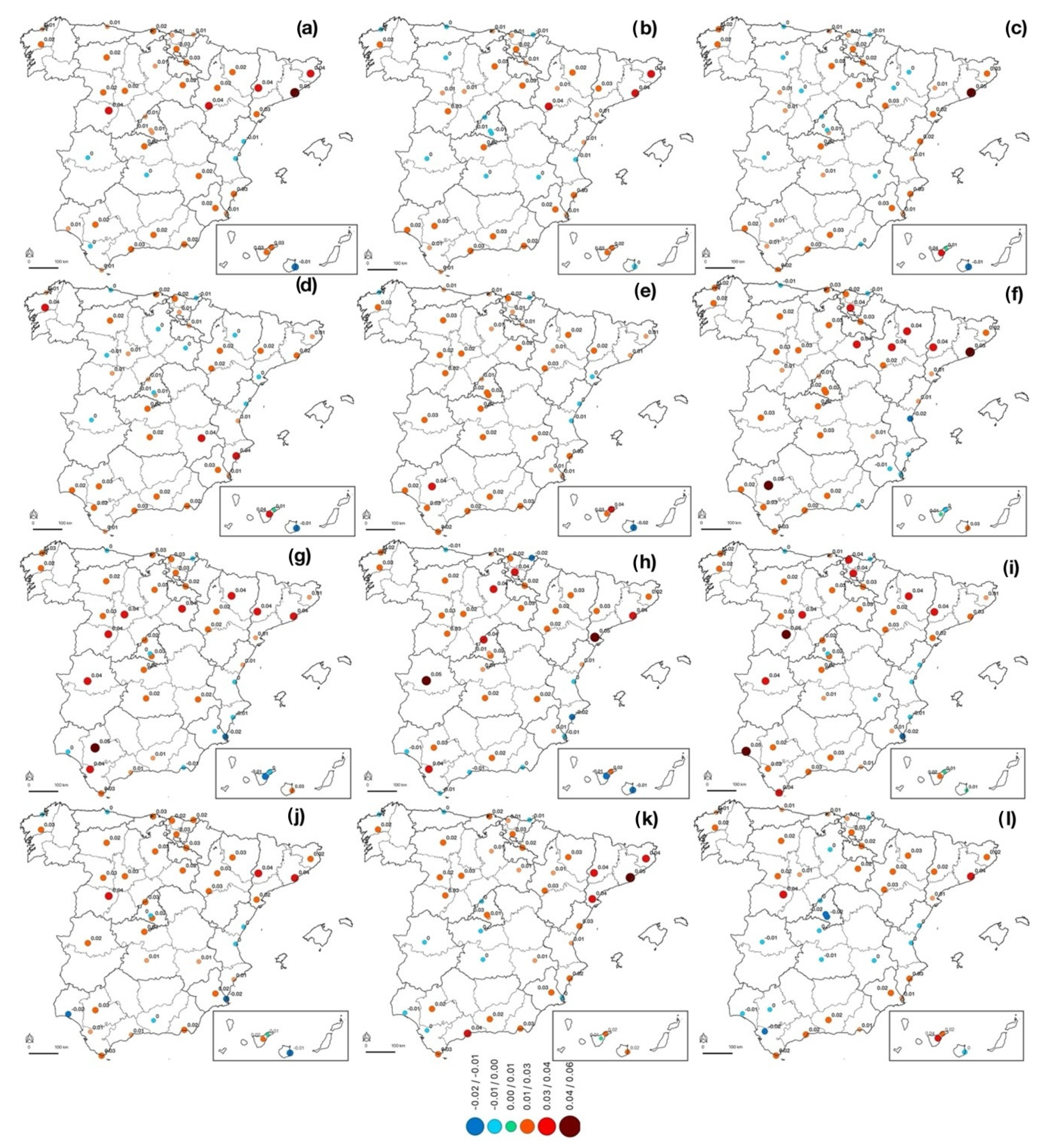
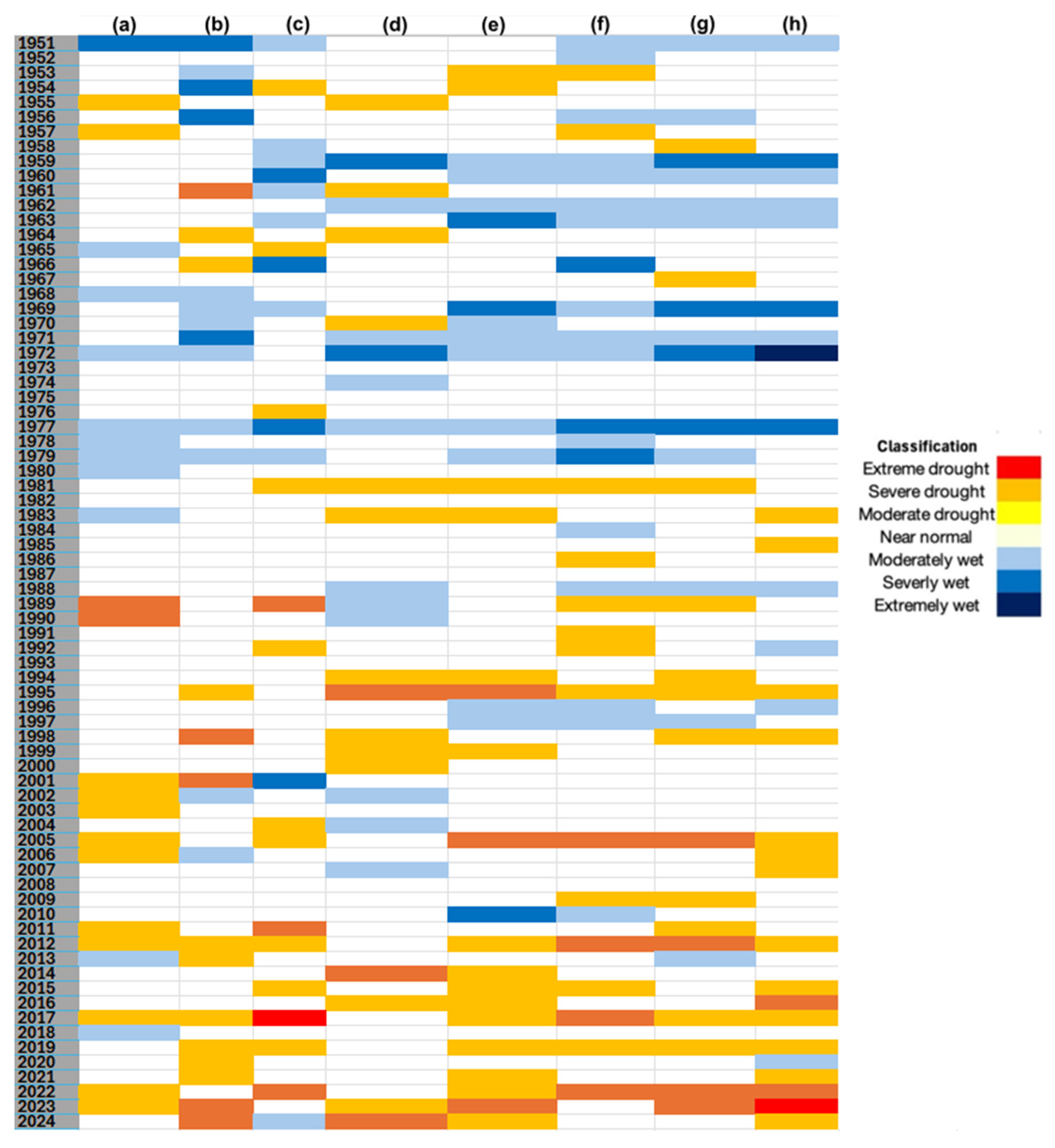
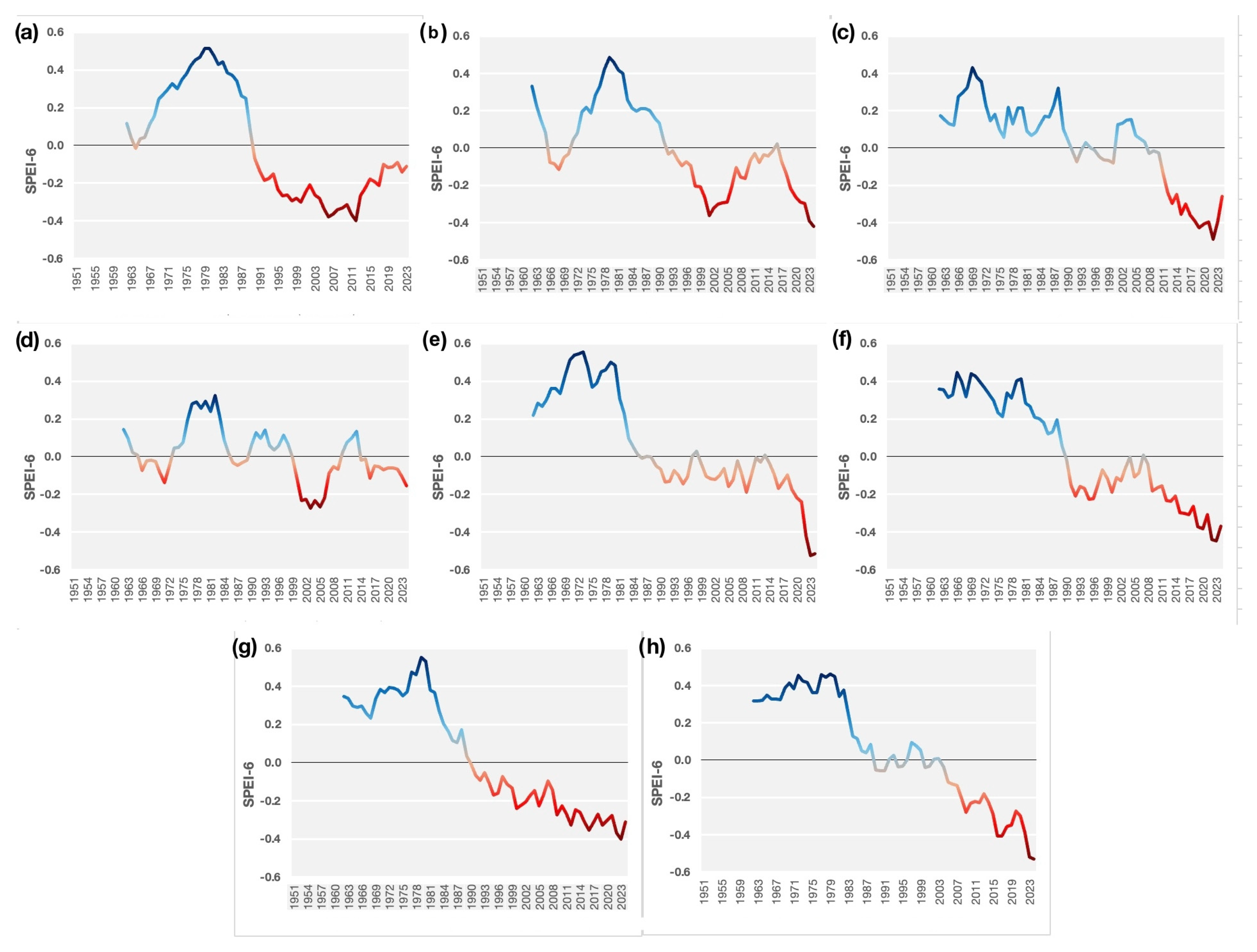

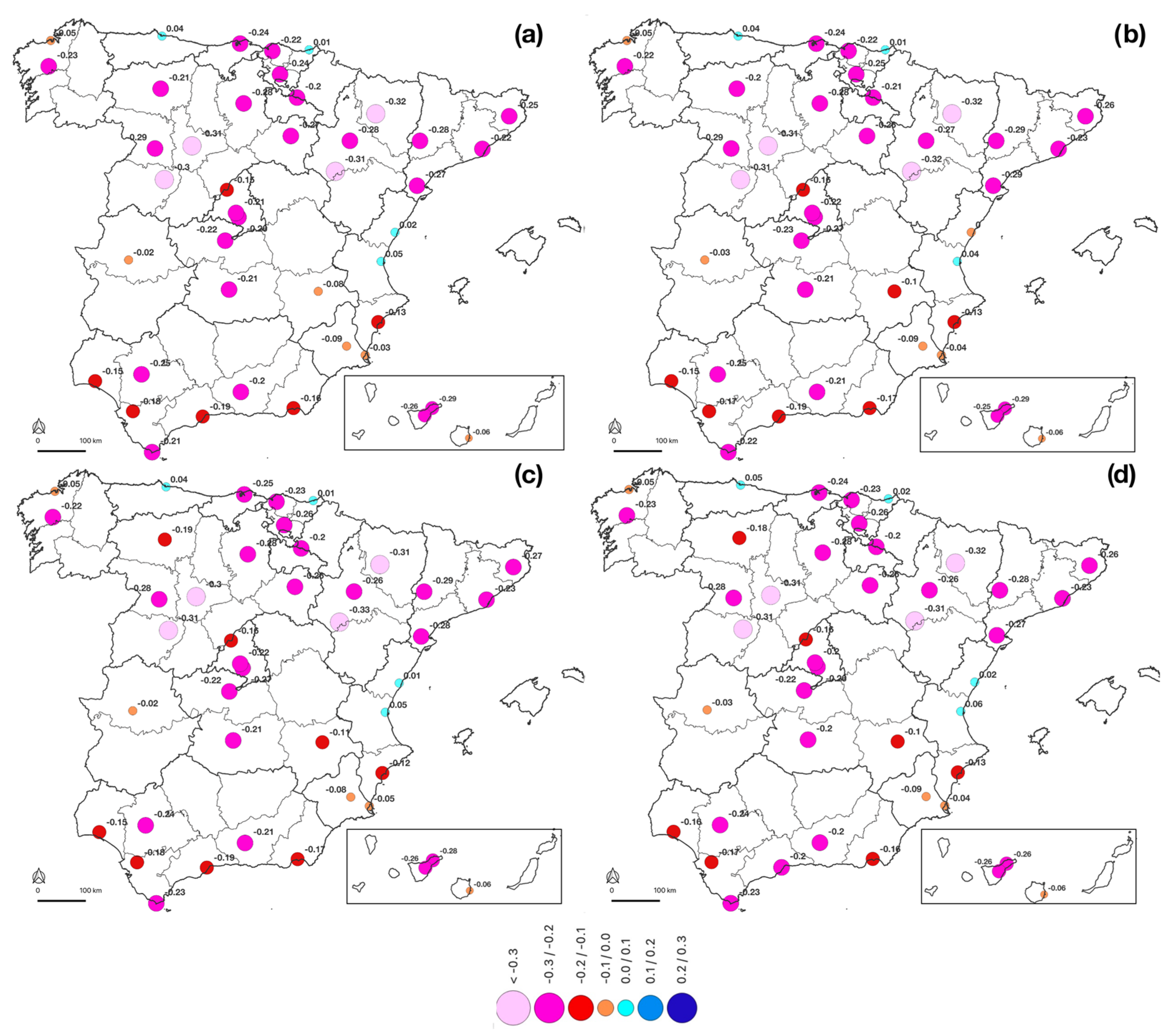
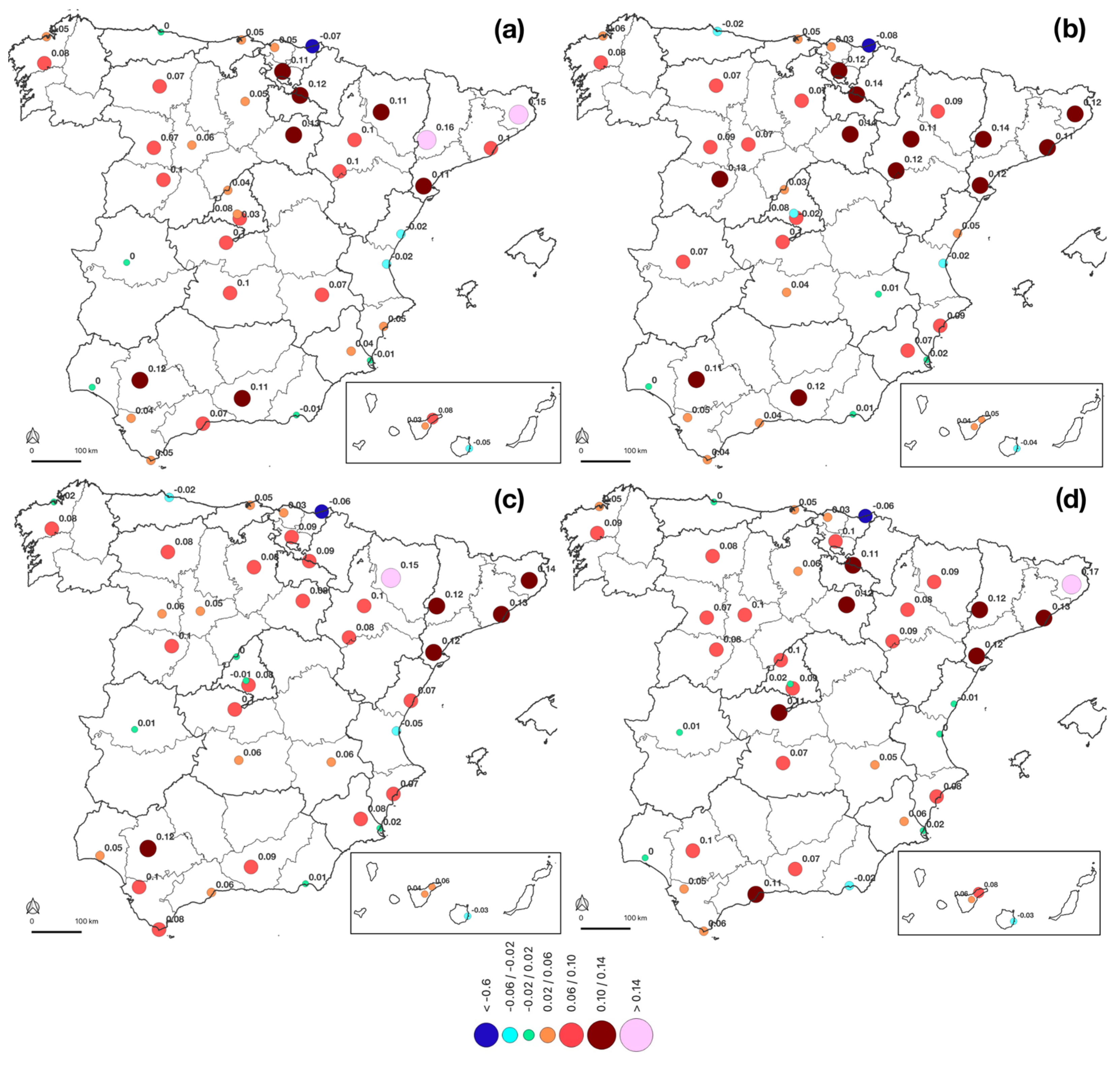


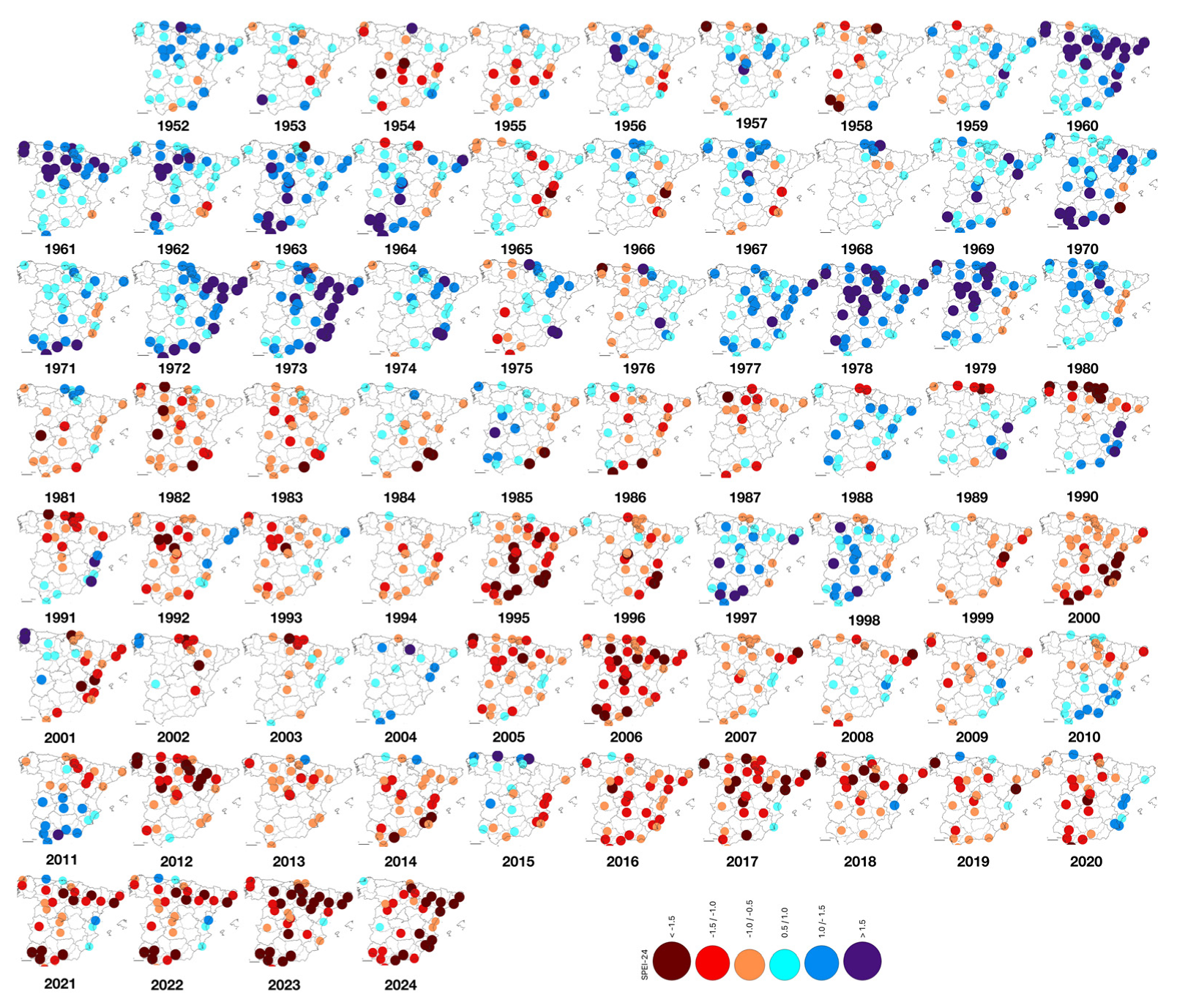
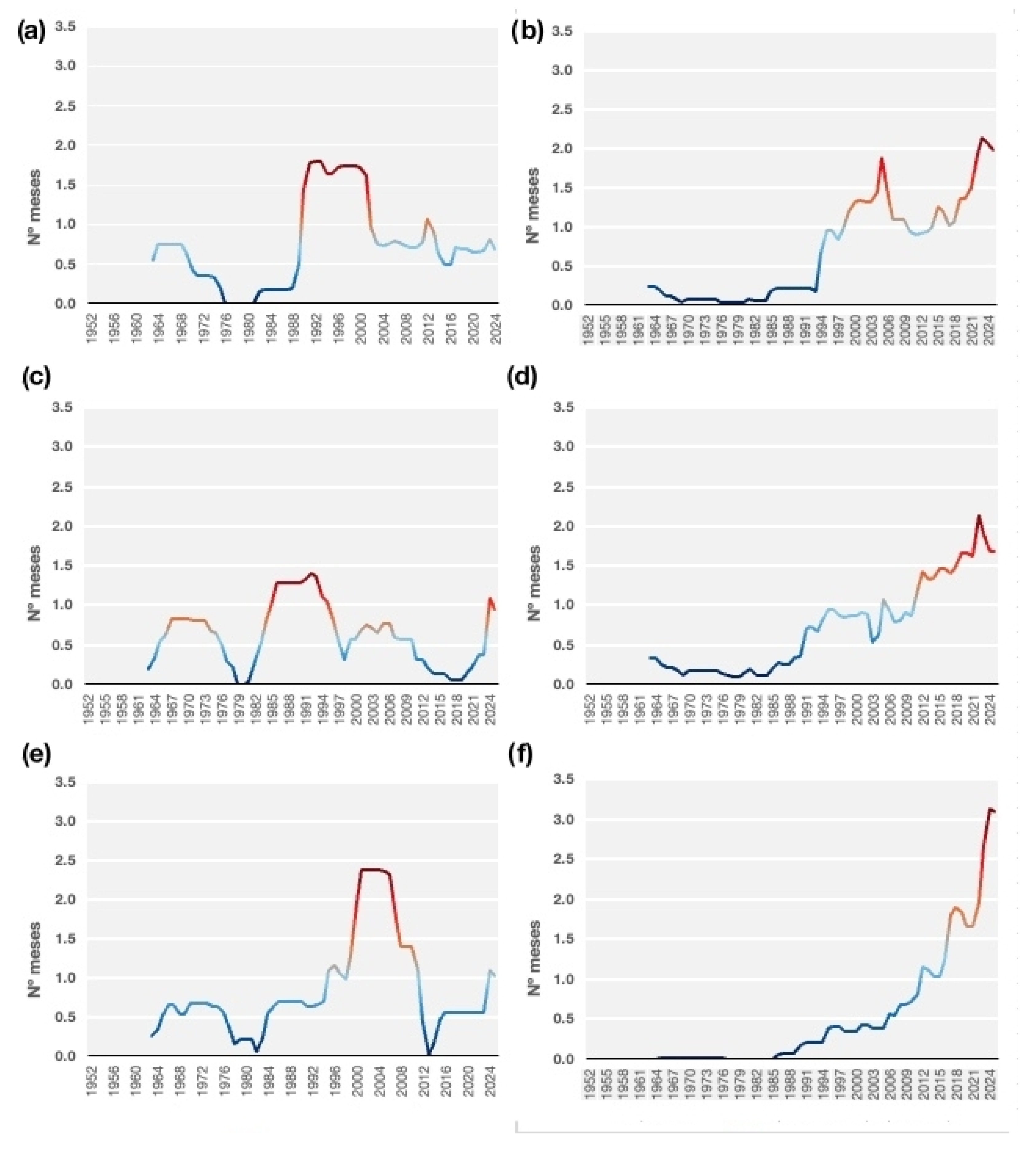

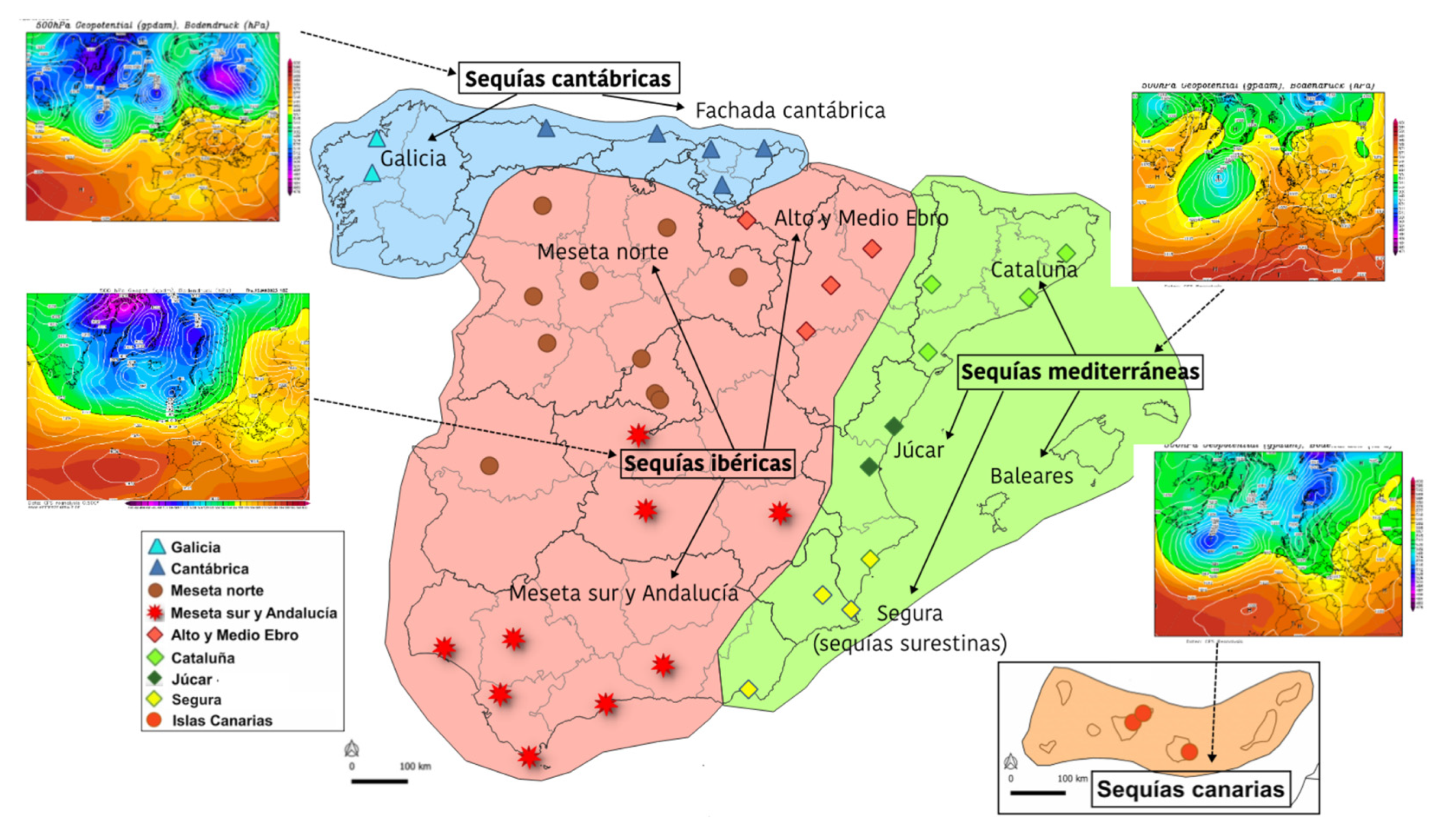

| ID | Observatory | Height (m) | ID | Observatory | Height (m) |
|---|---|---|---|---|---|
| 0200E | Barcelona (Fabra) | 408 | 5783 | Sevilla/Airport | 34 |
| 0367 | Girona/Costa Brava | 95 | 5960 | Jerez de la Frontera/Airport | 27 |
| 1024E | San Sebastián/Igueldo | 258 | 6001 | Tarifa | 32 |
| 1082 | Bilbao/Airpot | 42 | 6155A | Málaga/Airport | 5 |
| 1111 | Santander CMT | 59 | 6325O | Almería/Airport | 21 |
| 1207U | Gijón-Campus | 3 | 7031X | Murcia/San Javier | 4 |
| 1387E | A Coruña/Airport | 97 | 7228 | Murcia/Alcantarilla | 75 |
| 1428 | Santiago/Airport | 370 | 8025 | Alicante | 81 |
| 2030 | Soria | 1082 | 8175 | Albacete/Airport | 702 |
| 2331 | Burgos/Airport | 891 | 8414A | Valencia/Airport o | 56 |
| 2462 | Navacerrada | 1894 | 8500A | Castellón/Almazora | 43 |
| 2539 | Valladolid/Airport | 849 | 9091R | Vitoria/Airport | 513 |
| 2614 | Zamora | 654 | 9170 | Logroño/Airport | 353 |
| 2661B | León/Aeropuerto | 926 | 9390 | Daroca | 779 |
| 2867 | Salamanca/Airport | 793 | 9434 | Zaragoza/Airport | 263 |
| 3196 | Madrid/Cuatro Vientos | 690 | 9771C | Lleida | 185 |
| 3200 | Madrid/Getafe | 620 | 9981A | Tortosa | 50 |
| 3260B | Toledo | 515 | 9898 | Huesca | 541 |
| 3469A | Cáceres | 405 | C430E | Izaña | 2371 |
| 4121 | Ciudad Real | 628 | C447A | Tenerife/Airport | 632 |
| 4642E | Huelva, Ronda Este | 20 | C649I | G. Canaria/Airport | 24 |
| 5514 | Granada/Air Base | 687 |
| Category | SPEI |
|---|---|
| Extreme drought | <−1.5 |
| Severe drought | −1.5/−1.0 |
| Moderate drought | −1.0/−0.5 |
| Normal conditions | −0.5/0.5 |
| Moderately wet | 0.5/1.0 |
| Severely wet | 1.0/1.5 |
| Extremely wet | >1.5 |
| Nº Events Droughts | Duration | Intensity | |
|---|---|---|---|
| Region/Droughts Type | <−1.5 (3 Days Cons.) | Nº Months | SPEI-6 |
| Cantabrian | 0.06 | 0.36 | −0.08 |
| Canarian | 0.05 | 0.34 | −0.07 |
| Galician | 0.05 | 0.39 | −0.07 |
| Mediterranean | 0.03 | 0.23 | −0.03 |
| Andalusian-Manchegan | 0.03 | 0.21 | −0.03 |
| Central-Leónese | 0.09 | 0.50 | −0.12 |
| NE Iberian interior | 0.07 | 0.46 | −0.10 |
| Catalonian | 0.08 | 0.59 | −0.10 |
| Nº Events Droughts | Duration | Intensity | |
|---|---|---|---|
| Region/Drought Type | <−1.5 (3 Days Cons.) | Nº Months | SPEI-6 |
| Cantabrian | 0.05 | 0.41 | −0.06 |
| Canarian -Almerian | 0.04 | 0.37 | −0.05 |
| Mediterranean | 0.02 | 0.31 | −0.03 |
| Andalusian -Manchegan | 0.04 | 0.82 | −0.05 |
| NW Central -Leónese | 0.04 | 0.54 | −0.05 |
| NE Iberian interior | 0.05 | 0.72 | −0.06 |
| SPEI-6 (Short Term) | SPEI-24 (Long Term) | |
|---|---|---|
| Extreme events (<1.5) | Central -Leonese (0.09) Mediterranean (0.03) | Cantabrian (0.05) Mediterranean (0.02) |
| Duration (m/dec) | Central -Leonese (0.50) Andalusian–Manchegan (0.21) | Andalusian -Manchegan (0.82) Mediterranean (0.31) |
| Intensity (SPEI/dec) | Central -Leonese (−0.12) Mediterranean (−0.03) | Cantabrian (−0.06) Mediterranean (−0.03) |
| Extreme months (<−1.5) | Catalonia (0.3) Mediterranean (0.1) | NE Iberian interior (0.5) Mediterranean (0.1) |
| Intensity months (SPEI/dec) | Catalonia (−0.2) Mediterranean (0.0) | NE Iberian interior (−0.3) Mediterranean (0.0) |
| Seasonality | Declines Jun–Oct (northern half) Catalonia (−0.2/dec) Mediterranean (0.0/dec) | Homogeneous declines NE interior (−0.3/dec) Med/Cantabrian (n.s) |
Disclaimer/Publisher’s Note: The statements, opinions and data contained in all publications are solely those of the individual author(s) and contributor(s) and not of MDPI and/or the editor(s). MDPI and/or the editor(s) disclaim responsibility for any injury to people or property resulting from any ideas, methods, instructions or products referred to in the content. |
© 2025 by the authors. Licensee MDPI, Basel, Switzerland. This article is an open access article distributed under the terms and conditions of the Creative Commons Attribution (CC BY) license (https://creativecommons.org/licenses/by/4.0/).
Share and Cite
Sánchez, D.E.; Cantos, J.O. One Country, Several Droughts: Characterisation, Evolution, and Trends in Meteorological Droughts in Spain Within the Context of Climate Change. Climate 2025, 13, 202. https://doi.org/10.3390/cli13100202
Sánchez DE, Cantos JO. One Country, Several Droughts: Characterisation, Evolution, and Trends in Meteorological Droughts in Spain Within the Context of Climate Change. Climate. 2025; 13(10):202. https://doi.org/10.3390/cli13100202
Chicago/Turabian StyleSánchez, David Espín, and Jorge Olcina Cantos. 2025. "One Country, Several Droughts: Characterisation, Evolution, and Trends in Meteorological Droughts in Spain Within the Context of Climate Change" Climate 13, no. 10: 202. https://doi.org/10.3390/cli13100202
APA StyleSánchez, D. E., & Cantos, J. O. (2025). One Country, Several Droughts: Characterisation, Evolution, and Trends in Meteorological Droughts in Spain Within the Context of Climate Change. Climate, 13(10), 202. https://doi.org/10.3390/cli13100202







